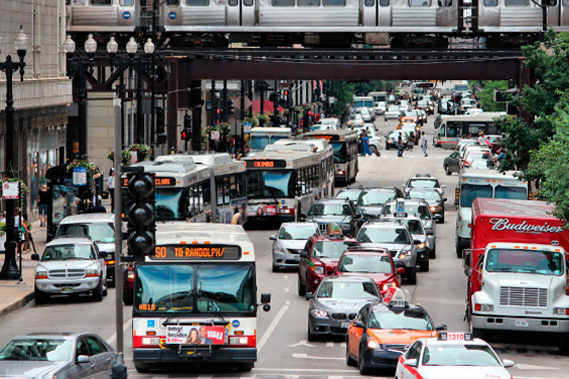Toll Free + 1 (800) 245-7660
7 February 2020
Connected transit signal priority

Roads are being made safer – and transit more efficient – thanks to vehicle-to-infrastructure technology that allows transit vehicles to be prioritized at intersections.
Transit signal priority (TSP) is a concept that has existed for decades. The basic concept is that a transit vehicle (such as a bus, streetcar or light rail) passes over a transit specific detector at a fixed point from a signalized intersection, and the traffic controller at the intersection runs a special program to advance the vehicle through the intersection more efficiently. This is typically only triggered when the vehicle is behind schedule and needs assistance to make up time.
Technological progress
Over the years, traffic controllers have become more intelligent and efficient in their optimization strategies, but simple detection technology has remained somewhat stagnant and has limited what could be achieved at intersections. With advances in automatic vehicle location (AVL) systems and communications networks, this is now changing rapidly. AVL systems use onboard computers and global positioning systems (GPS) to dispatch and track transit vehicles. By connecting the vehicles’ AVL systems and the next generation of intelligent signalized intersections through wireless communications, a new era of collaboration between vehicles and infrastructure has been made possible.
Now, instead of a fixed-point on or off signal to the traffic controller, the vehicle can communicate in real time, giving its identity, location, course of action and estimated time of arrival (ETA). In doing so it can basically call ahead to the intersection and make a reservation. This is beneficial for the transit vehicles and also for the driving public. With advance warning that a transit vehicle is approaching and needs prioritization (i.e. it is behind schedule), the intelligent traffic controller can optimize the transit vehicle’s progression through the intersection without overly disrupting other users of the road.
Knowing in advance the vehicle’s route and ETA, an intelligent traffic controller can compare the anticipated arrival of the transit vehicle at the forecast location with its timing cycle and make gradual timing changes to accommodate the vehicle. In addition some traffic controllers (as with Signal Group’s GREENWave-enabled advanced traffic controllers [ATC] family of controllers) have sophisticated algorithms to gradually recoordinate the signals back into the familiar ‘green band’ without major traffic disruptions.
System benefits
There are many other advantages to transit vehicle-to-infrastructure (T-V2I) cooperation. First, the computer estimated time and distance calculations can change as conditions evolve. If the vehicle slows down or speeds up, it can send update messages to the traffic controller to amend its ETA – the vehicle communicates initially and ‘checks in’. It then continually sends update status messages to the intersection until the time it passes through the intersection and ‘checks out’. Also, if the vehicle catches up with its schedule before it arrives at the intersection and no longer needs priority, it can cancel its request and resume normal operation.
The flexibility of the real-time communications allows a single system to be implemented in the most complex transit systems. The vehicle, based on its own settings, will know what program on the traffic controller to request priority on. There could be multiple transit routes through a single intersection, special transit-only movements (for example, left turns for buses) and transit-only queue jumps exiting bus stops.
Having an intelligent system that can request the correct program is critical. It also cannot be overlooked that the communications work both ways. In the T-V2I model, the vehicle can receive status information from the intersection so that it knows if the intersection heard, understood and is acting upon the priority requests.
V2I interoperability
Another benefit of the T-V2I model is that the vehicle can be positively identified and logged by the intelligent traffic controller. As an example, when an AVL-equipped bus communicates to the traffic controller, it can send its vehicle number, the agency/operator it belongs to, and the route and run it is on. With this identification, the intelligent traffic controller can track how much adjustment (green extensions and reductions, movement skips, shifts, etc) was made and how much vehicle travel time was saved. Other metrics can also be tracked, including how long the vehicle was in the intersection’s TSP system and how many cycles the bus had to wait in congestion. With this data, performance can be measured, tracked and improved to answer the everlasting question – “How are we doing?” in terms of performance.
Finally, when pairing the T-V2I model with standardized communications protocols like National Transportation Communications for ITS Protocol (NTCIP), it adds levels of interoperability never seen before. As an example, the Chicago area transit agencies are executing the Regional Transit Signal Priority Implementation Program (RTSPIP). They designed an interoperable protocol message set that allows vehicles from multiple overlapping transit agencies and multiple equipment manufacturers (AVL, traffic controllers, priority request generators/servers, etc) to communicate with one another. This allows transit vehicles to seamlessly request priority while traversing from the suburbs to the cities and back.
As many countries and companies are advancing in the connected vehicle arena and looking to the future, T-V2I technology is here and is a model that has generated many lessons learned.

Gustavo de la Peña VP Sales
Subscribe to our Newsletter
Get information about our latest innovations, upcoming events and industry news.

